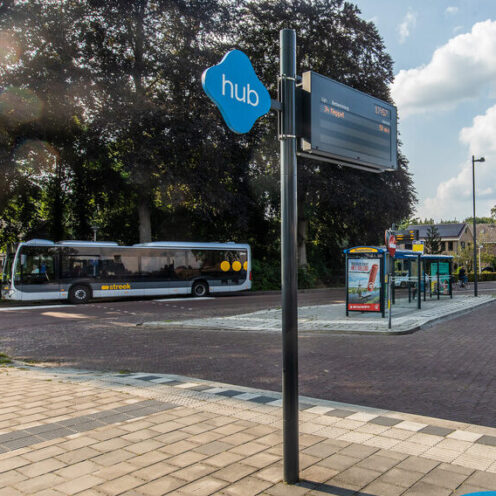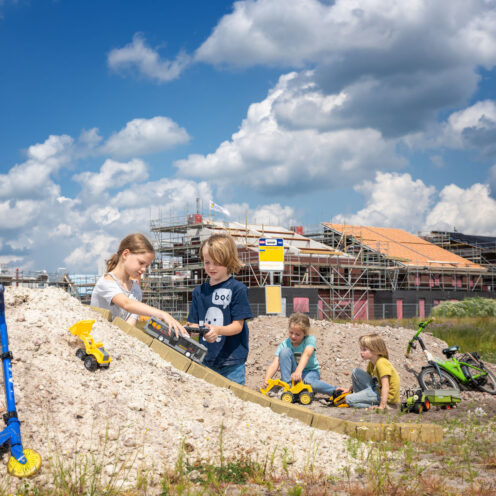Public transport network
The transport basis of the public transport in Groningen and Drenthe is the public transport network. It is based in the environmental visions of the provinces of Groningen and Drenthe. This public transport network consists of three types of interconnected and complementary types of public (bus) transport and a related physical infrastructure:
- High-quality public transport (HQPT network): train, Qliner and Q-link.
- Basic network: city and regional lines.
- Ancillary network: school lines, hub taxi and other ancillary transport services.
High-quality public transport
Qliners complement the rail network on long distances. In addition, Q-link buses connect the region with a maximum of one change to the important economic core areas and the P+R locations in and around the city of Groningen. A Q-link bus also runs between Emmen and Klazienaveen. Together, Qliner and Q-link form the high-quality public transport (HQPT); it can compete with travelling by car, is fast and frequent with few but good stops.
The routes of the Qliner and Q-link are established for the long term. With these two high-quality public transportation products, we currently serve about 60% of our travellers and our ambition is to attract even more passengers with these high-quality lines.
The concessions for regional rail transport are the responsibility of the provinces.

Basic network
In addition to the HQPT network, there are regional lines that provide bus connections between the larger towns. The city lines in Emmen, Assen and Groningen provide accessibility to the neighbourhoods and the city centre. In principle, all of these buses run on all days and at least once an hour, also in the evenings and weekends. Connections to hubs make Groningen and Drenthe optimally accessible. The connections in the basic network are guaranteed for at least 10 years, the exact routing can be adapted according to travel needs. The basic lines currently carry about 30% of our passengers.

Ancillary network
Where there is no regular public transport, but at times there is a need for a transport facility, we provide a number of additional transport services, consisting of local buses and a hub taxi, under the direction of Publiek Vervoer. Local transport initiatives such as volunteer projects are also supported within Publiek Vervoer. These services do not carry many passengers, but they do contribute to the accessibility and therefore viability of the rural area. The OV-bureau supports the organisation Publiek Vervoer.
Generally speaking, the OV-bureau pays constant attention to social issues with a mobility component. In consultation with each other, we help find solutions to these issues and the role that public transport – whether or not as part of more comprehensive ‘transport chains’ with different modalities – can play in this respect.
Hubs
Where there is no regular public transport, but at times there is a need for a transport facility, we provide a number of additional transport services, consisting of local buses and a hub taxi, under the direction of Publiek Vervoer. Local transport initiatives such as volunteer projects are also supported within Publiek Vervoer. These services do not carry many passengers, but they do contribute to the accessibility and therefore viability of the rural area. The OV-bureau supports the organisation Publiek Vervoer.
Generally speaking, the OV-bureau pays constant attention to social issues with a mobility component. In consultation with each other, we help find solutions to these issues and the role that public transport – whether or not as part of more comprehensive ‘transport chains’ with different modalities – can play in this respect.

The public transport network in the future
We want to further strengthen the hierarchy in the network (HQPT, basic network and ancillary network) in the coming years. This is in line with the wishes and needs of travellers and is future-proof from a financial and economic point of view. Wherever there is potential for growth, we aim for passenger growth in public (bus) transport and related growth in passenger revenues.
We work on continuous improvement of issues such as ‘the bus product’ and through-flow, consistent concession management and targeted marketing and promotion. As a result, more and more public transport passengers are experiencing better and better service and we are contributing to urban accessibility, the opening up of rural areas and sustainability. Motorists are encouraged to travel with public transport.
In addition, it is our ambition to further improve the connection with other forms of transport (walking, cycling, car, sharing systems). We do this in cooperation with the aforementioned partners. This fits in well with what has been formulated in the lecture programmes of the provinces of Groningen and Drenthe and Groningen Municipal Council.
Housing assignment
In the coming years, new residential areas will be built or expanded on a large scale. Living in a pleasant living environment is important to everyone. The design of the public space plays a major role in estabishing this. For example, the space designed for the car cannot be used for greenery, recreation or extra housing. Public transport can play an important role in smart and pleasant design of the living environment. The OV-bureau Groningen Drenthe describes in its vision document that by strategically placing the bus in the district from the very beginning, the bus, together with the bicycle and sharing concepts, often becomes an attractive and affordable alternative to the (second) car.



